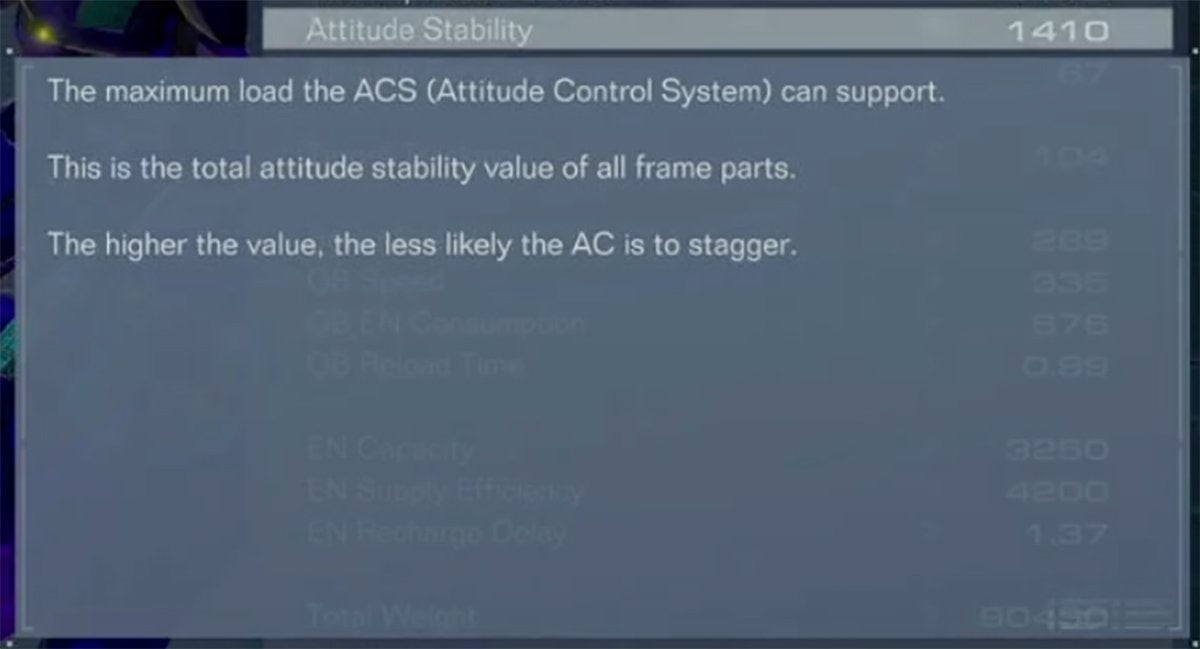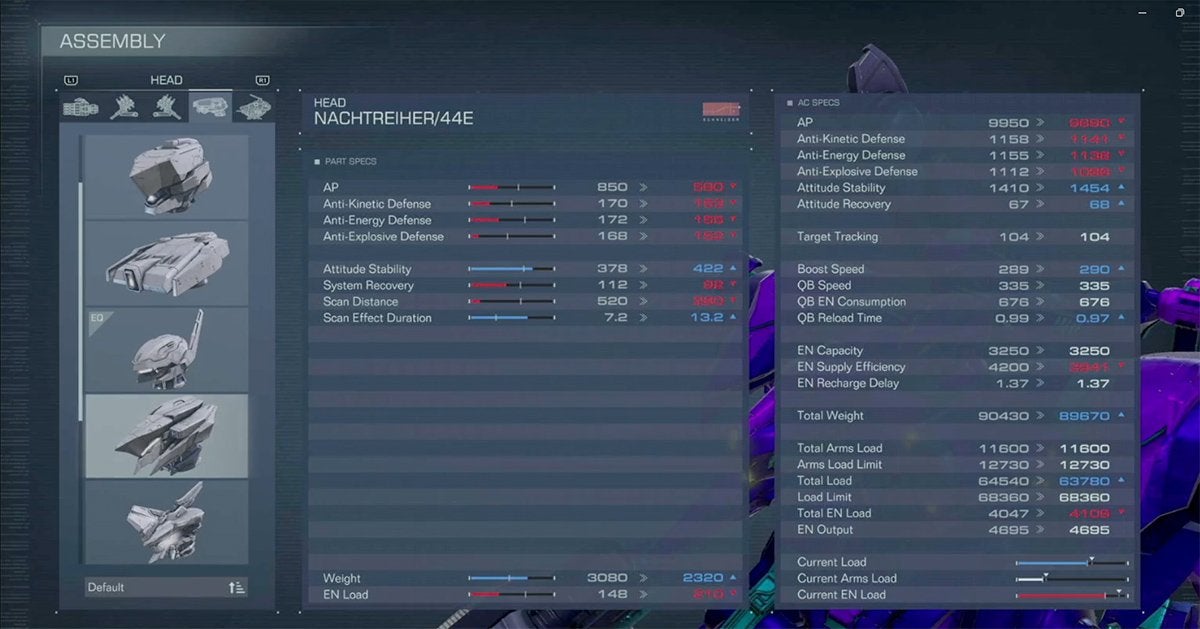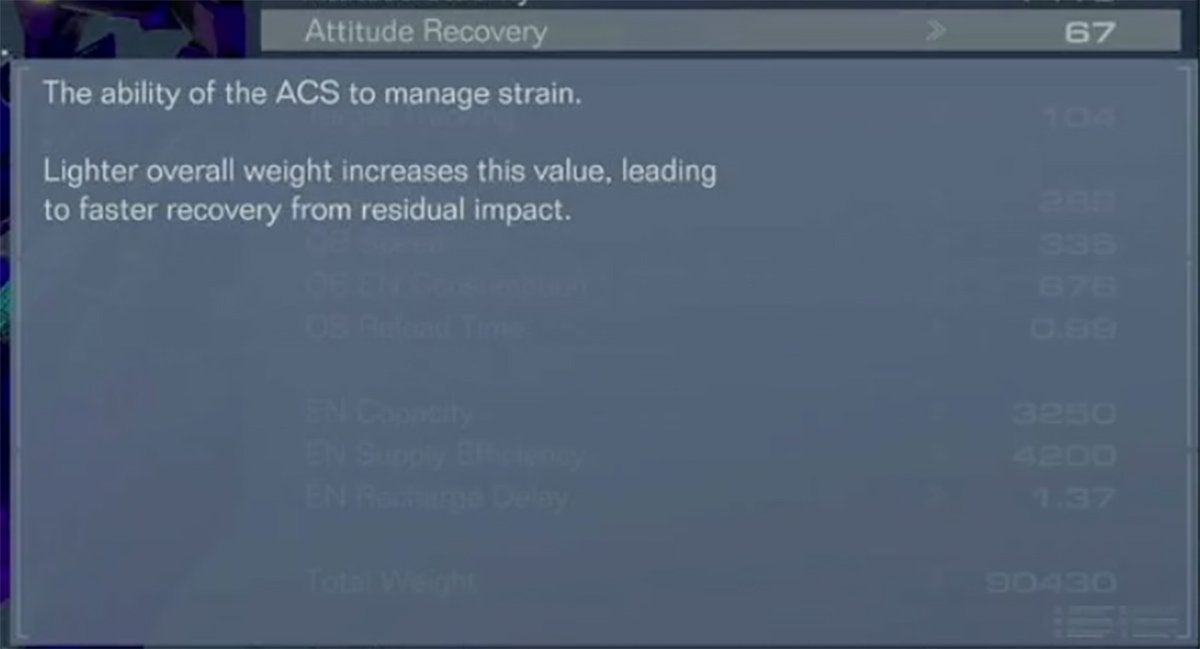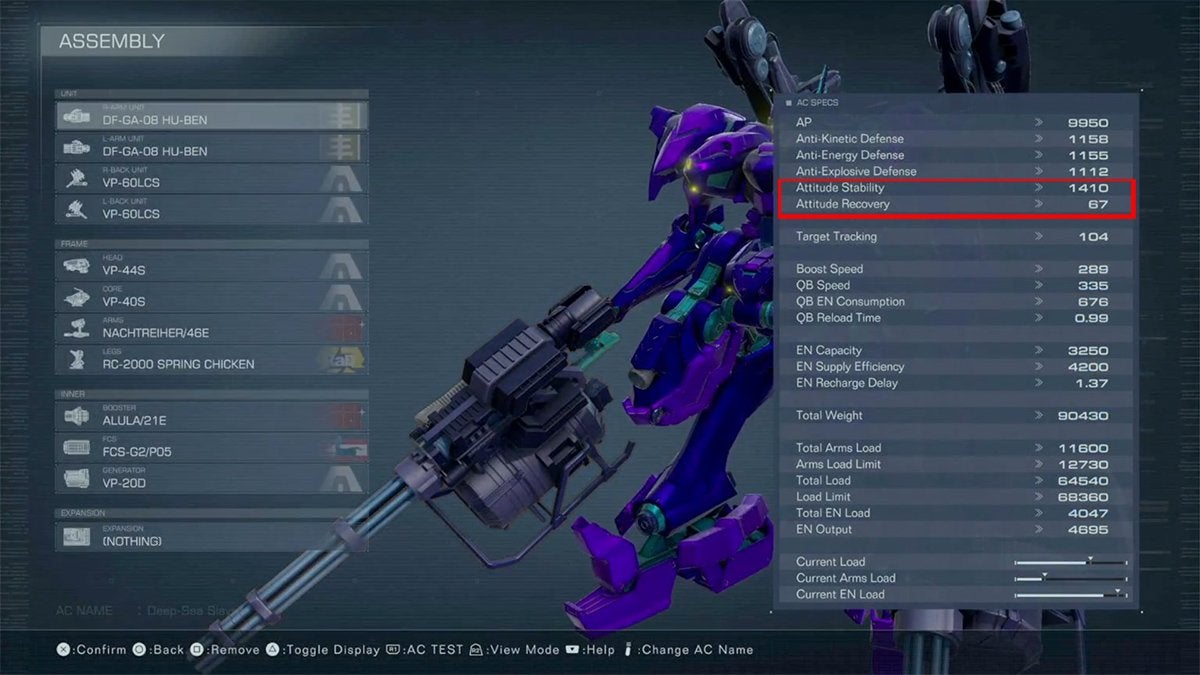![]() Key Takeaway
Key Takeaway
The higher your armored core’s Attitude Stability, the more Impact it can take before getting staggered. A higher Attitude Stability directly slows down how fast your ACS (stagger meter) fills up.
The higher an AC’s Attitude Recovery stat, the quicker it can move again after getting staggered, and the quicker your ACS bar decreases if it is partially full.
You should understand Attitude Stability and Attitude Recovery in Armored Core 6 if you wish to win fights. The former determines how easy it is for an AC to get staggered and the latter relates to how fast an AC can move again after being staggered.
Table Of Contents
About Attitude Stability
The higher an armored core’s Attitude Stability stat, the more Impact it takes to stagger it. Let’s look at the in-game definition of this stat.

The third point in the Contextual Help box pictured above verifies what we just said. However, let’s delve into the details of the other two points for clarity.
- The first point mentions your AC’s “ACS”—which is a fancy in-game way of referring to your ‘stagger meter.’ You can see your ACS just above your EN bar when you’re on a mission. When the ACS bar fills up completely, you’ll get staggered.
- The second point mentions that only ‘frame’ parts affect your Attitude Stability—which means only head, core, arm, and leg parts affect this stat.
There isn’t any true correlation between a frame part’s Attitude Stability and its other stats. You’d assume that frame parts with higher defensive stats grant higher Attitude Stability, but this is not the case.
For example, the Nachtreiher/44E head part has somewhat low defensive stats yet possesses fairly high Attitude Stability.

As such, if you need to prevent getting staggered, be sure to pay close attention to the head, core, arm, and leg parts you equip. No other type of part affects Attitude Stability.
How Impact Affects Attitude Stability
After you wrap your head around the Attitude Stability stat, you should learn how the Impact stat of a weapon affects it. Most weapons in the game apply a different amount of Impact per shot they unload. The higher a weapon’s Impact stat, the more quickly successful shots will fill an enemy’s ACS (stagger meter). However, the key term here is “successful shots.”
Slower weapons tend to apply a lot of Impact per individual round; however, you can also apply a lot of Impact with a fast-firing weapon. In fact, since the latter has faster-moving rounds and you can unleash more of them during the same time span, it can be better to choose a weapon with a high Rapid Fire stat if you want to stagger an enemy. With that said, this heavily depends on the enemy.
For instance, if you’re hunting down a swift adversary, trying to hit them with a bazooka’s slow yet mighty rounds will result in a lot of misses. Alternatively, using a weapon with a higher fire rate (yet lower Attack Power and Impact stats) like a Gatling gun helps you fill a foe’s ACS more efficiently. Even if a lot of your rounds miss, the few that do contribute more to staggering them than the near-consistent misses with weapons that have slower-moving rounds.
The opposite is true as well. Slower and bulkier enemies can soak up a lot of Impact—yet can’t dodge attacks as well. As such, using a bazooka on this kind of target would help you stagger it more than unloading hundreds of Gatling gun rounds.
About Attitude Recovery
Although Attitude Stability and Attitude Recovery in Armored Core 6 are tied closely, they are separate stats. The higher an AC’s Attitude Recovery stat, the quicker it can move again after getting staggered, and the quicker your ACS bar decreases. Once more, let’s look at the in-game definition to start our explanation…however, this one isn’t as helpful.

If you’re asking yourself “What in the Fires of Ibis does this even mean?”, you’re a logical human who is rightfully dissatisfied with this stat’s in-game explanation. The vague terms “manage strain” and “residual impact” are virtually useless for helping players understand how Attitude Recovery affects an AC. The only useful wording here is the mention of equipping lighter parts to increase Attitude Recovery.
To translate ‘FromSoftwarese’ to English:
- “The ability of the ACS to manage strain” = How fast your ACS (stagger meter) decreases
Your ACS bar increases as you receive Impact from enemy attacks and it decreases when you aren’t receiving Impact. The higher your Attitude Recovery, the quicker your ACS bar decreases when you’re not receiving Impact.
- “…leading to faster recovery from residual impact” = How fast you can move again after getting staggered
When you’re staggered, you can’t move for a moment. The duration of this moment is tied directly to your Attitude Recovery. As such, the higher your Attitude Recovery, the quicker you’ll be able to move again after getting staggered.
How to Increase Attitude Recovery
From the one useful part of this stat’s in-game description, it’s clear that heavier ACs take longer to recover from getting staggered than lighter ones. This makes sense and has a fair trade-off. Heavy ACs can take more Impact before being staggered but take longer to recover from getting staggered. The opposite applies to light ACs.
Every part you equip contributes to your Attitude Recovery. This means all weapons, frame parts, and inner parts affect this stat.
With that said, the difference between 67 and 68 Attitude Recovery is minimal. There’s likely only a few milliseconds worth of difference for minor tweaks. You’ll need to make major changes to notice any true difference in performance.
Attitude Stability and Attitude Recovery are important stats to understand despite the game not explaining them very well. The names of some of them don’t tell you what they do. This is the case with Fiream Specialization and a few others.
However, it can be argued that this is part of the charm of a futuristic mech game. Furthermore, it’s very much FromSoftware’s style to be this cryptic. Though, we can’t even blame Miyazaki for this one, as Masaru Yamamura’s in charge this time.


